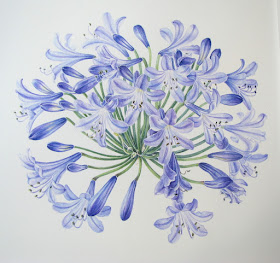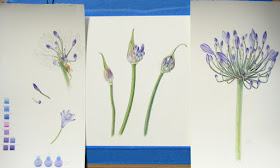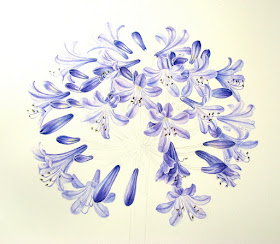
Agapanthus africanus WIP © Shevaun Doherty 2015
“Perseverance, secret of all triumphs.”
Victor Hugo
 |
Agapanthus africanus WIP © Shevaun Doherty 2015
“Perseverance, secret of all triumphs.”
Victor Hugo
|
I am not a flower painter.
Don’t get me wrong, I adore
flowers of every kind, and I really admire artists who can capture that
transient beauty with what seems like effortless grace. I’m just far happier
painting fruit, seeds and dried plants, where I can indulge myself in the
luxury of time, knowing that they aren’t going to wilt before my eyes.
 |
| Initial studies |
The Agapanthus africanus is really not for the faint
hearted. It’s a big robust ball of blueness that stands out taller than it’s
neater cousins, Agapanthus praecox. Whilst doing my bud studies, I noticed with
a bit of alarm, that there were over 50 flowers in each umbel! (I counted them in a fit of procrastination) Okay, so they
weren’t all going to open at the same time, but once they started to open, it
was definitely going to be a race against time.
So how to start?
There are lots artists who very successfully draw out the complete flower and work on it as a whole. This approach can be great as it gives greater control over the tones. However that method doesn’t really work from me. I spent my first day carefully drawing out all the flowers, only to discover that they had changed shape overnight. Buds had popped open and flowers that were open had folded over. My big blue monster was not going to be easy.
There are lots artists who very successfully draw out the complete flower and work on it as a whole. This approach can be great as it gives greater control over the tones. However that method doesn’t really work from me. I spent my first day carefully drawing out all the flowers, only to discover that they had changed shape overnight. Buds had popped open and flowers that were open had folded over. My big blue monster was not going to be easy.
The key to success is determination. If one technique doesn’t
work, try another. There really isn’t a right way or wrong way, but it’s a case
of finding a method that suits your style.
For me, that meant concentrating in
smaller, more manageable sections.
The flowers themselves are a simple funnel shape with six
petals, six long elegant stamens and a shorter stigma. I found it easier to
paint the stamens first with a tiny brush, a steady hand and a magnifier.
Concentrating
on just the flowers meant that my palette was quite simple too. I used Daniel
Smith Verditer for the first wash and dropped in some ultramarine violet whilst
wet, particularly on the central stripes which have a soft edge. I carefully
painted around the stamens. I used the same colours to build up the form, adding cobalt and
indanthrene towards the base of the flowers. In the places where it was very
dark, I added a tiny bit of indigo to the mix. I know that indigo is a bit
controversial because it can so easily muddy up the colours, but used
sparingly, it’s a handy pigment. The anthers which are dark green (indigo and
transparent yellow) were painted last.
 |
| The pedicels are sketched in lightly |
 |
| Working on a small section at a time, I draw it out first onto tracing paper |
 |
| I carefully redraw the image on the reverse using a HB pencil and then once more go over the lines right side up to transfer the drawing. I then remove the excess graphite using a putty rubber. |
I kept an eye on the overall shape as I added sections. As I worked, I fell into a rhythm,
starting with the foremost flowers and working backwards. I noted which buds
were about to open and made a mental note to work on those the next day. I
literally chased the flowers across the umbel. As flowers finished, I would
remove them so that I could see the ones behind more easily. I loved the dying
ones which twisted into great shapes, but had to resist the urge to add too many of them
because I wanted to capture the freshness.
Once I felt that I enough flowers to convey the fullness of
the umbel, I stopped. Now it was time for the greens. The pedicels lasted quite
well which is more than I can say for the poor agapanthus!
I did a quick colour
chart (any excuse!) and then started to add the pedicels. I kept the same blues
adding winsor lemon and transparent yellow to the mix. I have still got a lot to do before this is
finished, but I’m learning and I’m enjoying the process.
“Technique is only a vehicle.”
Callum Innes









Wonderful work Shevaun, and great explanation of your process with this incredibly complex flower.
ReplyDeleteThanks Polly!
DeleteLove your determination Shevaun, you're a winner, and your work is stunning.
ReplyDeleteClaire ❤️ Thank you!!! Xx
DeleteLove your paintings! Such a pity that you don't have online classes...
ReplyDeleteWilly, if you message me with your email address, I will contact you about this and also about Spain. You can contact me on my email address, through Facebook or send me a message here and I won't publish it. Thanks for asking
DeleteShevaun, do you give an art class in Spain?
ReplyDeleteSend me a message Willy!! I'll get back to you!
ReplyDeleteLovely work - and thanks for sharing how you go about it. Painting flowers may not be 'your thing' but you certainly achieved beautiful results.
ReplyDeleteThank you!
DeleteThis comment has been removed by the author.
ReplyDeleteWhat a mission and an adventure ! As Clare said your determination is fantastic and the results look amazing !
ReplyDeleteThanks Sarah! Your kind comment means a lot to me :)
DeleteThanks for sharing your process, it turned out wonderfully!
ReplyDeleteThanks Laura!
DeleteBellissimo Shevaun. In Italy Agapanthus is on fashion at the moment, it is in flower beds on main roads everywhere.
ReplyDeleteCiao
Here too, Renata! It's funny, I never really noticed them before, and now I'm seeing blue everywhere! They are gorgeous plants!
Delete